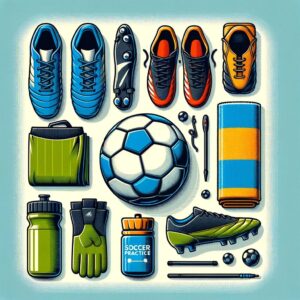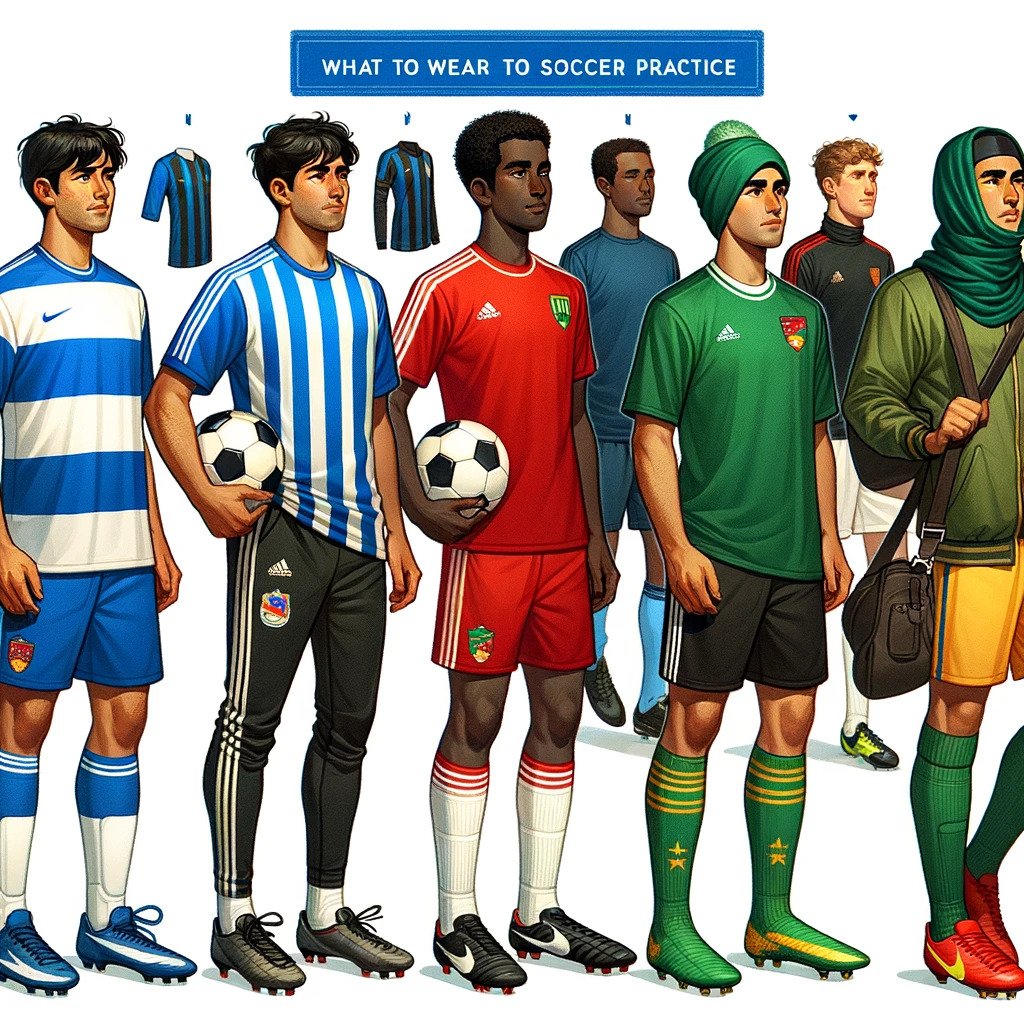As someone deeply familiar with both the business and athletic worlds, I’ve noticed a striking parallel in their paradigms. Just as the phrase “dress for success” carries significant ramifications in the corporate sphere, its mileage in sports is equally noteworthy. Many invest considerable thought and effort in assembling the perfect outfit for a business meeting or a party, overlooking the importance of the right attire for physical activities.
From my experience, wearing proper clothes on the field can greatly boost your confidence and comfort, just as it does in a boardroom.
When it comes to choosing the right apparel for soccer practice, it’s not just about making a hefty investment in sports clothing. Unlike other sports, soccer doesn’t demand extensive spending on its gear. However, certain must-have items are essential to stay safe and have fun.
The key is to find balance – clothes that allow you to move freely without sweating excessively, yet durable enough to endure the rigors of the game. Remember, the right soccer gear can significantly impact your performance, ensuring you are always prepared to play at your best.
The essentials for a soccer practice
When gearing up for soccer practice, it’s crucial to have the right equipment. Here’s a listicle of essential items every soccer player should have:
- Soccer Cleats: A good pair of cleats is essential for traction and agility on the field. They provide the necessary grip to maneuver quickly and efficiently.
- Shirt and Shorts: Comfort is key when playing soccer. A lightweight and breathable shirt paired with shorts allows for maximum mobility and keeps you cool during intense play.
- Proper Underwear: Often overlooked, the right underwear can significantly impact your comfort level. Choose materials that offer support and are moisture-wicking to stay comfortable throughout the game.
- Shin Guards: Protecting your shins is crucial in soccer. Shin guards help shield your legs from impacts and injuries during tackles and collisions.
- Socks: A good pair of socks not only completes your kit but also provides additional cushioning and helps keep your shin guards in place.
Each of these items plays a vital role in ensuring both your comfort and safety on the soccer field.
What to wear to a soccer practice?

When it comes to soccer practice, your gear is not just about style; it’s about safety and fun. The right equipment plays a crucial role in how effectively you can play while staying safe.
Selecting the Right Shirts
Your choice in Shirts is your first primary step. Whether it’s a team’s jersey or a uniform for practice, ensure it matches the team’s colors. However, considering the weather is key. On a cool day, opt for long sleeves under a short-sleeved t-shirt to stay warm.
Choosing Comfortable Shorts
Shorts are essential for freedom of movement. They should be loose, typically hitting around the mid-thigh to allow you to move comfortably. Comfortable elastic bands at the waist ensure maneuverability. In colder weather, consider wearing compression shorts under your regular soccer shorts for added warmth.
Importance of Proper Cleats
Cleats are arguably the most important part of your uniform. These shoes are designed to grip the grass or turf, with cone-like studs on the sole aiding in running on wet or softer grounds. Remember, the softer the ground, the longer the cleats required.
The Role of Socks in Soccer
Socks in soccer are not just any special shoes; they are designed to go above the knee and keep your shin guard in place as you run across the field. A good pair of moisture-wicking socks are vital, especially on a warm day to keep your feet dry and non-sticky. Consider custom soccer socks for the perfect fit and comfort.
Protecting Your Shins
In soccer, Shin Guards are essential equipment. They are worn on the front of the shin to protect against injury from errant kicks and fast-moving balls. Soccer involves a lot of action with feet and legs, so guarding your shins is a must to reduce the risk of being kicked in the leg during scrimmaging.
Can You Wear Sweatpants To Soccer Practice?
When the weather is cold, it’s natural to think about wearing sweatpants to soccer practice, especially during warmup. Many people own these comfortable pants and wonder if they’re suitable for the field.
The short answer is that while you might be able to wear them, they’re not the ideal solution. Loose sweatpants at the bottom can easily get caught in cleats or be stepped on by players, posing a tripping risk. However, Jogger-style sweatpants with a fitted ankle can be a more doable option.
Yet, cotton sweatpants are not ideal as they hold onto moisture, becoming soaked and heavy if it’s wet outside. A better alternative is specialized soccer pants, designed for the sport, lightweight, and moisture-wicking.
These pants are more fitted and don’t get caught or stepped on. Another ideal option is sports tights, which can be worn under shorts for added warmth. Their tight fit ensures they don’t pose a safety risk. Furthermore, many sports tights come in moisture-resistant and moisture-wicking materials, offering optimal comfort and functionality on the field.
What Do Soccer Players Wear Under Their Uniforms?
Beneath the traditional uniforms, soccer players wear a variety of essential items that are crucial for both comfort and performance during games and practice. It’s a common misconception that athletes wear ONLY their team’s uniforms.
In reality, they layer several things underneath to enhance their gameplay and protect themselves. For instance, a sports bra is often essential for female athletes, providing necessary support. A heart rate monitor is another common undergarment, helping players keep track of their physical exertion.
In addition to these, Spandex or sports underwear are preferred for their snug fit and ability to reduce chafing. An undershirt, be it a t-shirt or a tank top, is another layer often worn under the jersey for added comfort. During cold weather, a long-sleeve shirt can provide extra warmth.
Lastly, Wraps or sleeves are used to support and protect against lingering injuries, ensuring that the player stays safe on the field. These undergarments play a vital role in a soccer player’s gear, often overlooked but critically important for peak performance and safety.
Is Proper Attire Mandatory For Soccer Practice?
In the world of soccer, especially for younger players, the question of whether to wear specific attire to practice often arises. Generally, there isn’t a stringent requirement for specific gear. However, a request is often made for younger players to have a reversible jersey in some cases.
This aids in teams identification and makes organizing practice matches easy. A more common request is that every player must have cleats, not just for uniformity but as a safety concern and ensuring they have the right equipment for the sport.
As for the rest of the attire, it’s mostly left to the parents’ discretion. They are responsible for packing layers for colder temperatures, bringing along extra shoes, and ensuring multiple jersey options are available. The key is to be prepared for varying weather conditions and the demands of the game. Soccer’s great appeal is its simplicity in terms of equipment needed for play. As long as the basics are covered, the focus can remain on the joy of the game itself.
Conclusion
Dressing appropriately for soccer practice is about balancing comfort, safety, and adherence to team requirements. Whether you’re a budding toddler player, a teenage soccer enthusiast, or an adult partaking in the sport, wearing the right gear – including a soccer jersey, shorts, cleats, shin guards, and appropriate undergarments – is crucial. Not only does this ensure your safety and enhance your performance on the field, but it also fosters a sense of team spirit and discipline.
Remember, the key to a successful soccer practice begins with what you wear, so always choose your soccer attire thoughtfully, keeping in mind the specific needs of your role and the weather conditions.
Frequently asked questions
What must you wear during a soccer game?
During a soccer game, players should wear a soccer jersey, soccer shorts, soccer cleats, shin guards, and soccer socks. Goalkeepers may also need goalkeeper gloves and additional protective gear.
How should a soccer player dress?
A soccer player should dress in a comfortable, team-specific soccer uniform consisting of a jersey, shorts, cleats, shin guards, and long socks. The attire should allow for full mobility and provide adequate protection.
What do boys wear under soccer shorts?
Boys typically wear compression shorts or athletic briefs under their soccer shorts. These provide support and comfort while playing.
What do toddlers wear to soccer?
Toddlers playing soccer should wear comfortable athletic clothing, such as a lightweight t-shirt, shorts, and soccer shoes suitable for their age. Shin guards and long socks are also recommended for protection.
What do girls wear to soccer practice?
Girls usually wear a soccer jersey, shorts, cleats, and shin guards with socks to soccer practice. They may also wear sports bras for added support and compression gear under their shorts for comfort.
What is a soccer outfit called?
A soccer outfit is commonly referred to as a soccer uniform or kit. It typically includes a jersey, shorts, cleats, shin guards, and socks, designed specifically for playing soccer.

